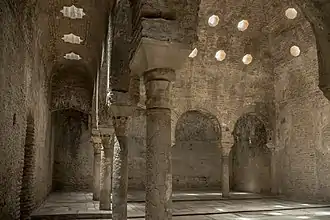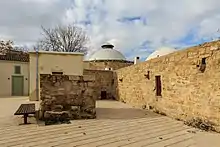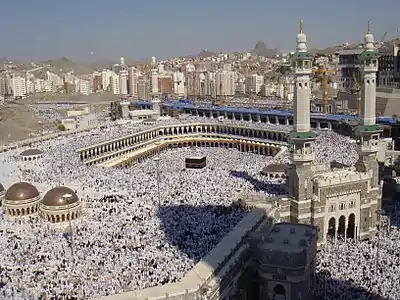Turkish bath
A Turkish bath or hammam (Turkish: hamam, Arabic: حمّام, romanized: ḥammām) is a type of steam bath or a place of public bathing associated with the Islamic world. It is a prominent feature in the culture of the Muslim world and was inherited from the model of the Roman thermae.[1][2][3] Muslim bathhouses or hammams are historically found across the Middle East, North Africa, al-Andalus (Islamic Spain and Portugal), Central Asia, the Indian subcontinent, and in central and Eastern Europe under Ottoman rule. A variation on the Muslim bathhouse, the Victorian Turkish bath, became popular as a therapy, a method of cleansing, and a place for relaxation during the Victorian era, rapidly spreading through the British Empire, the United States of America, and Western Europe.
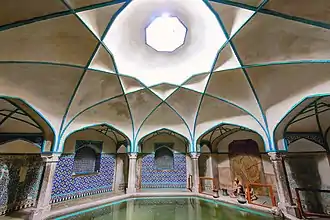
In Islamic cultures the significance of the hammam was both religious and civic: it provided for the needs of ritual ablutions but also provided general hygiene and served other social functions in the community such as a gendered meeting place for men and for women.[1][2][4] Archeological remains attest to the existence of bathhouses in the Islamic world as early as the Umayyad period (7th-8th centuries) and their importance has persisted up to modern times.[4][1] Their architecture evolved from the layout of Roman and Greek bathhouses and featured a regular sequence of rooms: an undressing room, a cold room, a warm room, and a hot room. Heat is produced by furnaces which provided hot water and steam, while smoke and hot air was channeled through conduits under the floor.[2][4][3] Visitors undress themselves, while retaining a loincloth, and proceed gradually into progressively hotter rooms, inducing perspiration. They are then usually washed by male or female staff (matching the sex of the visitor) with the use of soap and vigorous rubbing, before finishing off by washing themselves in warm water.[4] Unlike Roman or Greek baths, bathers usually washed themselves with running water rather than by immersing themselves in standing water,[2] although immersion in a pool was customary in the hammams of some regions such as Iran.[5] While the general principles are the same in all hammams, some details of the process and of the architecture vary from region to region.[4]
Etymology
The word "hammam" is a noun derived from the Arabic triconsonantal root ح م م which yields meanings related to heat or heating.[6][7] From Arabic حمّام (meaning "bath", "bathroom", "bathhouse", "swimming pool", etc) it passed on to Persian (حمام) and from there to Turkish (hamam).[8][9] The term "Turkish bath" in English is first recorded in 1644.[10]
History
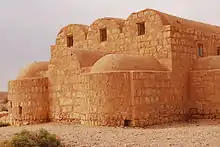

Origins and early development
Public bathhouses were a prominent civic and urban institution in Roman and Hellenistic culture and were found throughout the Mediterranean world even into early Byzantine times. Upon the expansion of Arab Muslim rule over much of the region in the 7th and 8th centuries, the emerging Islamic societies were quick to adopt this institution to their own needs. Its importance to Muslim society was ultimately guaranteed by the religious requirement of performing ablutions (wudu and ghusl) before prayers and by a general Islamic emphasis on physical and spiritual purity,[1][4] although the scholar Mohammed Hocine Benkheira has argued that hammams were not in fact necessary for religious purposes in early Islam and that this relation was partly presumed by later historians.[11] He argues that the hammam's initial appeal derived at least in part from its convenience for other services (such as shaving), from its endorsement by some Muslim doctors as a form of therapy, and from the continued popular appreciation of its pleasures in a region where they had already existed for centuries.[11] He also notes that there was initially strong opposition from many Islamic scholars (ulama), especially Maliki scholars, to the use of hammams.[11][12] These early ulama viewed hammams as unnecessary for the full-body ablutions (ghusl) and questioned whether public bathing spaces could be sufficiently clean to achieve proper purification. They also worried that spaces of collective bathing could become spaces for illicit sexual activity. Nevertheless, this opposition progressively faded and by the 9th century most scholars were no longer interested in debating the issue of the hammam, though it continued to be seen with suspicion in some conservative circles.[11]
The earliest known Islamic hammams were built in the region of Syria during the Umayyad Caliphate (661-750) as part of palaces and desert castles. These examples are found at Qusayr 'Amra, Hammam al-Sarah, Qasr al-Hayr al-Sharqi, and Khirbat al-Majfar.[1][3][4] Soon after this period, Islamic bathhouses are archeologically attested across much of the Muslim world, with hammams appearing as far away as Volubilis (itself a former Roman colony) in Morocco during the Idrisid period (late 8th to early 9th centuries).[13] Historical texts and archeological evidence also indicate the existence of hammams in Cordoba and in other cities of al-Andalus in the 8th century.[12] In Iran, which did not previously have a strong culture of public bathing, historical texts mention the existence of bathhouses in the 10th century as well as the use of hot springs for therapeutic purposes; however, there has been relatively little archeological investigation to document the early presence and development of hammams in this region.[14]

Muslims retained many of the main elements of the classical bathhouses while leaving out other functions which were less relevant to their practices. For example, the progression from cold room to hot room was maintained, but it was no longer common practice to take a plunge in cold water after leaving the hot room, nor was exercise incorporated into bathing culture as it was in classical gymnasiums.[13][1] Likewise, and more generally, Muslim bathers usually washed themselves in running water rather than immersing themselves in standing water.[2] Although in early Islamic history women did not normally patronize hammams, by around the 10th century it became common practice in many places to provide separate hours (or separate facilities) for men and women.[1] This allowed the hammam to acquire an important role in the social life of women as one of the few public spaces where they could gather and socialize away from men.[11][15] Hammams could be privately owned and integrated into palaces and mansions, but in many cases they acted as civic or charitable institutions which were part of a larger religious/civic complex. Such complexes were governed by waqf agreements, and hammams often acted as a source of revenue for the upkeep of other institutions such as mosques.[4][16]
Later developments
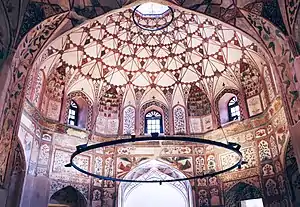
In the 11th century the Seljuk Empire conquered much of Anatolia from the Byzantine Empire, eventually leading to the complete conquest of the remnants of the old empire in the 15th century. During those centuries of war, peace, alliance, trade and competition, these intermixing cultures (Eastern Roman, Islamic Persian and Turkic) had tremendous influence on each other. The later Ottomans became prolific patrons of hammams. Since they were social centers as well as baths, they were built in almost every city across their European, Asian, and African territories. The Ottomans were thus responsible for introducing hammams throughout much of eastern and central Europe, where many still exist today in various states of restoration or disrepair. Such Turkish baths are found as far as Greece and Hungary.[17][18][19] Many early Ottoman hammams survive in Bursa and Edirne, as well as in Eastern Europe and Anatolia, but hammams became even more numerous and architecturally ambitious in Constantinople (Istanbul), thanks to its royal patronage and its access to plentiful water.[20] The city's historically Greek inhabitants had retained a strong Eastern Roman bath culture, with the Baths of Zeuxippus constituting a major previous example.[21] Ottoman architects expanded upon the experience of earlier Byzantine architects to create particularly well-balanced designs with greater symmetry and regularity in the arrangement of space than seen in hammams from other parts of the Muslim world.[4] Some of the city's oldest monumental hammams are the Tahtakale Hamam (probably built right after 1454), the Mahmut Pasha Hamam (built in 1466), and the Bayezid II Hamam (built some time between 1500 and 1507).[17] The monumental hammams designed by the 16th-century Ottoman architect Mimar Sinan (1489–1588), such as the Çemberlitaş Hamamı, the Süleymaniye Hamam (in the complex of the Süleymaniye Mosque), and the Haseki Hürrem Sultan Hamam, are among some major examples that were later built in the era of classical Ottoman architecture.[17] When Sultan Mustafa III issued a decree in 1768 halting the construction of new public baths in the city, this appears to have resulted in an increase in the number of private hammams among the wealthy and the elites, especially in the growing suburbs along the Bosphorus where they built their comfort homes.[20]
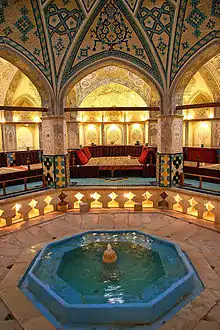
In Iran, many rich examples of hammams survive from the Safavid period (16th-18th centuries) and afterward, with the historic city of Isfahan in particular containing many examples.[16] The spread of Muslim rule on the Indian subcontinent also introduced hammams to this region, with many examples surviving in Mughal architecture (16th-19th centuries).[22]
Contemporary era
Hammams continued to be a vital part of urban life in the Muslim world until the early 20th century, after which point the spread of indoor plumbing in private homes made public baths unnecessary for hygiene.[1] This has resulted in an overall decline in their use – although to varying degrees depending on regional cultural practices. In many regions hammams have been either abandoned, demolished, or converted to other uses such as commercial buildings or cultural venues. Some have been converted to museums or art galleries, as with the examples of the Bayezid II Hamam in Istanbul and the Davud Pasha (or Daut Pasha) Hamam in Skopje, North Macedonia.[23]
In Turkey many historic hammams continue to operate for either locals or tourists, which in some cases has led to neglected historic hammams being renovated and returned to their original function, while others have been abandoned or repurposed.[24][25][23] In Morocco, many hammams continue to operate for locals in historic cities like Fes and Marrakesh, where they are especially useful to the urban poor residing in the old cities (medinas).[13][2][26] In many other regions, however, hammams have become obsolete and have either been abandoned or converted to other uses. In Iran, some baths continue to operate in the historic districts of cities like Isfahan where they continue to serve religious functions, but there is an overall decline in their numbers. Many surviving Iranian examples have been converted to other uses, most notably as restaurants and teahouses.[16] In Damascus, Syria, only 13 hammams were still operating in 2004, mostly in the old city, with many others having been either demolished or repurposed.[2] Cairo once contained an estimated 77 operational hammams at the beginning of the 19th century but only 8 were still operating at the beginning of the 21st century, with many others abandoned or neglected.[27] In the former European territories of the Ottoman Empire such as Greece and the Balkans many hammams have become defunct and have undergone a period of neglect in modern times, though many have been more recently restored and turned into historic monuments or cultural centers.[19][28]
Public bathing in the Islamic context

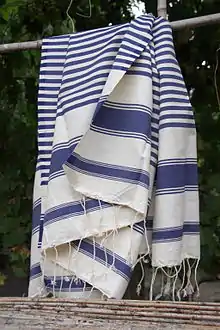
One of the Five Pillars of Islam is prayer. It is customary before praying to perform ablutions. The two Islamic forms of ablution are ghusl, a full-body cleansing, and wudu, a cleansing of the face, hands, and feet.[29] In the absence of water, cleansing with pure soil or sand is also permissible.[30] Mosques always provide a place to wash, but often hammams are located nearby for those who wish to perform deeper cleansing.[2]
Hammams, particularly in Morocco, evolved from their Roman roots to adapt to the needs of ritual purification according to Islam. For example, in most Roman-style hammams, one finds a cold pool for full submersion of the body. The style of bathing is less preferable in the Islamic faith, which finds bathing under running water without being fully submerged more appropriate.[2]
Al-Ghazali, a prominent Muslim theologian writing in the 11th century, wrote Revival of the Religious Sciences, a multi-volume work on dissecting the proper forms of conduct for many aspects of Muslim life and death. One of the volumes, entitled The Mysteries of Purity, details the proper technique for performing ablutions before prayer and the major ablution (ghusl) after anything which renders it necessary, such as the emission of semen.[31] For al-Ghazali, the hammam is a primarily male experience, and he cautions that women are to enter the hammam only after childbirth or illness. Even then al-Gazali finds it admissible for men to prohibit their wives or sisters from using the hammam. The major point of contention surrounding hammams in al-Ghazali's estimation is nakedness. In his work he warns that overt nakedness is to be avoided. "… he should shield it from the sight of others and second, guard against the touch of others."[32] He focuses extensively in his writing on the avoidance of touching the penis during bathing and after urination. He writes that nakedness is decent only when the area between the knees and the lower stomach of a man are hidden. For women, exposure of only the face and palms is appropriate. According to al-Gazali, the prevalence of nakedness in the hammam could incite indecent thoughts or behaviours and so it is a controversial space.[33] Ritual ablution is also required before or after sexual intercourse.[34] Knowing that, May Telmissany, a professor at the University of Ottawa, argues that the image of a hyper-sexualised woman leaving the hammam is an Orientalist perspective that sees leaving or attending the hammam as a sign of pre-eminent sexual behaviour.[27][35]
Bathing practices and services
The usual customs of a hammam require visitors undress themselves but retain a loincloth, and then proceed gradually from a cold room to progressively hotter rooms, inducing perspiration. They are then usually washed by male or female staff (matching the gender of the visitor) with the use of soap and vigorous rubbing, before finishing off by washing themselves in warm water. While the general principles are the same in most hammams, some details of the process vary from region to region, such as the presence or absence of pools where visitors can immerse themselves in water.[4]
The hammam, like its precursors, is not exclusive to men. Hammam complexes often contain separate quarters for men and women; or males and females are admitted at separate times. On many occasions they became places of entertainment (such as dancing and food, especially in the women's quarters) and ceremonies, such as before weddings, high-holidays, celebrating newborns, beauty trips.
Several accessories from Roman times survive in modern hammams, such as the peştemal (a special cloth of silk and/or cotton to cover the body, like a pareo), nalın (wooden clogs that prevent slipping on the wet floor, or mother-of-pearl), kese (a rough mitt for massage), and sometimes jewel boxes, gilded soap boxes, mirrors, henna bowls and perfume bottles.
Traditionally, the masseurs in the baths, tellak in Turkish, were young men who helped wash clients by soaping and scrubbing their bodies. After the defeat and dismemberment of the Ottoman Empire in the early 20th century, the role of tellak boys was filled by adult attendants.[36]
Massage
Massage in Turkish baths involves not just vigorous muscle kneading, but also joint cracking, "not so much a tender working of the flesh as a pummelling, a cracking of joints, a twisting of limbs".[37][38]
Social function: gendered social space
Arab hammams are gendered spaces where being a woman or a man can make someone included or a representative of the "other" respectively. Therefore, they represent a very special departure from the public sphere in which one is physically exposed amongst other women or men. This declaration of sexuality merely by being nude makes hammams a site of gendered expression. One exception to this gender segregation is the presence of young boys who often accompany their mothers until they grow old enough to necessitate attending the male hammam with their fathers.[39] The separation from the women's hammam and entrance to the male hammam usually occurs at the age of 5 or 6.[34]
As a primarily female space, women's hammams play a special role in society. Valerie Staats finds that the women's hammams of Morocco serve as a social space where traditional and modern women from urban and rural areas of the country come together, regardless of their religiosity, to bathe and socialise.[40] While al-Ghazali and other Islamic intellectuals may have stipulated certain regulations for bathing, the regulations, being outdated and fundamental, are not usually upheld in the everyday interactions of Moroccans in the hammam. Staats argues that hammams are places where women can feel more at ease than they feel in many other public interactions.[41] In addition, in his work "Sexuality in Islam," Abdelwahab Bouhiba notes that some historians found evidence of hammams as spaces for sexual expression among women, which they believed was a result of the universality of nudity in these spaces.[42]
Architecture
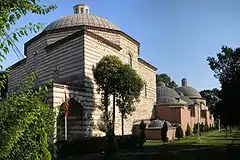
.jpg.webp)
General design
The hammam combines the functionality and the structural elements of its predecessors in the Roman thermae with the Islamic tradition of steam bathing, ritual cleansing and respect of water.[43] Moving beyond the reuse of the Greek and Roman baths, Islamic bathhouses were often constructed as annex buildings of mosques which were part of larger complexes acting as both community centres and houses of worship.[4]
Although there were variations across different regions and periods, the general plan and architectural principles of hammams were all similar. They consisted of a regular sequence of rooms which bathers visited in the same order: the changing room or undressing room (corresponding to the Roman apodyterium), the cold room (like the Roman frigidarium), the warm room (like the tepidarium), and the hot room (like the caldarium). The nomenclature for these different rooms varied from region to region. The changing room was known generally as al-mashlaḥ or al-maslakh in Arabic, or by local vernacular terms like goulsa in Fez (Morocco) and maḥras in Tunisia, whereas it was known as the camekân in Turkish and the sarbineh in Persian. The cold room was known as the bayt al-barid in al-Andalus, el-barrani in Fez, bayt awwal in Cairo, and soğukluk in Turkish. The warm room or intermediate room was known as bayt al-wastani in al-Andalus and many other regions, as el-wasti in Fez, as bīt əs-skhūn in Tunis, and as ılıklık in Turkish. The hot room was called the bayt al-sakhun in al-Andalus, ad-dakhli in Fez, harara in Cairo, garmkhaneh in Persian, and hararet or sıcaklık in Turkish.[4][1][44][2][13][24]
These main chambers of the hammam are usually covered in vaulted or domed ceilings, which gives them a distinctive profile on the urban skyline. The domes and vaults of the steam rooms (especially the hot room) are notable for being pierced with small holes or skylights which provided natural lighting during the day and allowed excess steam to escape.[1][4] The ceiling and the walls are clad with steam-proof materials such as varnished plaster or (for the lower walls and floors) marble.[4] The vestibule or changing room is typically one of the most decorated chambers of the complex, often featuring a central fountain and equipped with benches.[14][4] In Ottoman baths, the changing room was ringed with multi-level wooden galleries which gave access to smaller rooms for changing.[17]:160 Toilets or latrines were historically often included at some accessible location in the complex.[2][14]
Most historic hammams made use of some version or derivation of the Roman hypocaust system for heating.[1][2] A furnace or set of furnaces were located in a service room behind the walls of the hot room and set at a lower level than the steam rooms. The furnaces were used to heat water (usually in a large cauldron above the furnace) which was then delivered to the steam rooms. At the same time, hot air and smoke from the furnaces was channeled through pipes or conduits under the floor of the steam rooms, thus heating the rooms, before rising through the walls and out the chimneys. As hot water was constantly needed, they were kept burning throughout hours of operation. Although wood was continuously needed for fuel, some hammams, such as those in Morocco and Damascus, also made use of recycled organic materials from other industries such as wood shavings from carpenters' workshops and olive pits from the olive presses.[2]
Variations
Regional variations in hammam architecture usually concern the relative proportions of each room or the absence of one type of room. In the Maghreb and especially in al-Andalus, the largest and most important steam room was typically the warm room (al-wastani). One of the more drastic examples of this is the Arab Baths of Jaén, where the warm room is as large as both the cold room and the hot room combined, possibly because it was the room also used for body massages and other services.[12] The changing room was also fairly large and was typically the only space to feature any significant architectural decoration.[3]
In Ottoman baths the cold room and the changing room are generally combined together (as the camekân or soğukluk) and is often the largest and, again, the most decorated room of the complex. This room usually features a central fountain (shadirvan) and is ringed with wooden galleries. It is also used as a place to relax, drink (tea, coffee, or sherbet), and socialize both before and after bathing.[17] In contrast with hammams in al-Andalus or the Maghreb, the warm room (ılıklık) was architecturally de-emphasized and could be little more than a transition space between the cold and hot rooms.[17][24] The hot room, however, is another part of the complex which was often the focus of architectural embellishments.[17] In its center is usually a large heated marble table (göbek taşı or navel stone) that customers lie on.
In Egypt and in Iran a shared pool or basin of hot water is commonly present in the center of the hot room where bathers would immerse themselves a few times, a feature which was rare or absent in the hamams of other regions.[1][14][5] Iranian hammam architecture was also characterized by the polyhedral shape of its rooms (sometimes rectangular but often octagonal or hexagonal), covered by a dome with a central skylight. The Iranian hot room (garmkhaneh) was in some cases divided into several rooms: a large main one with a central pool (chal howz) and smaller ones which could serve for individual ablutions or were used as private rooms for special guests.[16]
Some hammams were "doubled", having separate facilities for women and for men. A number of Istanbul's larger hammams were like this, including the Bayezid II Hamam and the Haseki Hürrem Sultan Hamam.[17][24] The Hammam as-Saffarin in Fez is another example, although this was not typical of most historic hammams in Morocco.[13] In other cases, a single set of facilities usually operated different hours for men and for women.[2]
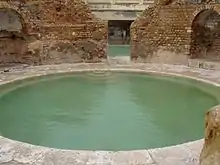
.jpg.webp) The vaulted chambers of the Umayyad bathhouse at Qusayr 'Amra, covered in Late Roman or Byzantine-style frescoes (7th or 8th century)
The vaulted chambers of the Umayyad bathhouse at Qusayr 'Amra, covered in Late Roman or Byzantine-style frescoes (7th or 8th century) Remains of the hammam at the Citadel of Aleppo, Syria (c. 1200)
Remains of the hammam at the Citadel of Aleppo, Syria (c. 1200)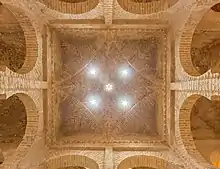 The vaulted ceiling of the hammam in the Almohad-era Alcázar of Jerez de la Frontera, Spain (12th century)
The vaulted ceiling of the hammam in the Almohad-era Alcázar of Jerez de la Frontera, Spain (12th century)
 Interior of the Mahmut Pasha Hamam in Istanbul (1476)
Interior of the Mahmut Pasha Hamam in Istanbul (1476) Muqarnas decoration around the domes of the Ottoman-era Davud Pasha Hamam in Skopje, North Macedonia (late 15th century)
Muqarnas decoration around the domes of the Ottoman-era Davud Pasha Hamam in Skopje, North Macedonia (late 15th century)
 Renovated interior of the Haseki Hurrem Sultan Bathhouse (16th century)
Renovated interior of the Haseki Hurrem Sultan Bathhouse (16th century)
 Frescoed/painted decoration in a hammam from the reign of Shah Abbas I in Mashhad, Iran (16th or 17th century)
Frescoed/painted decoration in a hammam from the reign of Shah Abbas I in Mashhad, Iran (16th or 17th century)
_(16864981308).jpg.webp)

 Interior of the Ali Gholi Agha Hammam in Isfahan, Iran (early 18th century)
Interior of the Ali Gholi Agha Hammam in Isfahan, Iran (early 18th century) A modern hotel hammam catering to tourists in Istanbul
A modern hotel hammam catering to tourists in Istanbul
Regional examples
Jordan
Jordan contains several examples of hammams from the Umayyad era (7th to 8th centuries), making them the oldest known examples of Islamic bathhouses. Many of these are attached to the so-called "desert castles". They include Qusayr 'Amra, Hammam al-Sarah, and Qasr al-Hayr al-Sharqi.[1][3][4] Qusayr 'Amra is particularly notable for its range of frescoes in late Roman style decorating the interior of the hammam chambers, presenting a highly important example of Islamic art in its early historical stages.[45]
Morocco
.jpg.webp)
The ruins of the oldest known Islamic hammam in Morocco, dating back to the late 8th century, can be found in Volubilis.[13] Public baths in Morocco are embedded into a social-cultural history that has played a significant role in both urban and rural Moroccan cities. These public spaces for cleansing grew rapidly as Islamic cultures assimilated to the bathing techniques widely used during the Roman and Byzantine periods.[2] The structure of Islamic hammams in the Arab world varies from that of what has been termed the traditional “Roman bath.” Additionally, since Morocco (unlike Egypt or Syria) was never under Ottoman rule, its baths are not technically Turkish although guide books might refer to them as such. This misnomer can be due in part to the Arabic use of the word hammam, which translates to “bathroom” or “public bath place” and can be used to refer to all baths, including those in the Turkish and Roman design.
Hammams in Morocco are often close to mosques to facilitate the performance of ablutions. Because of their private nature (overt nudity and gender separation), their entrances are often discreet and the building's façade is typically windowless. Vestiges of Roman bathing styles can be seen in the manifestation of the three-room structure, which was widespread during the Roman/Byzantine period.
In Morocco, hammams are typically smaller than Roman/Byzantine baths. While it may be difficult to identify a hammam from the face of the structure, the hammam roof betrays itself with its series of characteristic domes that indicate chambers in the building.[46] Hammams often occupy irregularly shaped plots to fit them seamlessly into the city's design. They are significant sites of culture and socialisation as they are integrated into medina, or city, life in proximity to mosques, madrassas (schools) and aswaq (markets). Magda Sibley, an expert on Islamic public baths writes that second to mosques, many specialists in Islamic architecture and urbanism find the hammam to be the most significant building in Islamic medinas.[46] Many historic hammams have been preserved in cities like Marrakesh[47] and especially Fez, partly thanks to their continued use by locals up to the present day.[2][13] Among the better-known examples of preserved historic hammams in Morocco is the 14th-century Saffarin Hammam in Fez, which has recently undergone restoration and rehabilitation.[2][48][49][13]
Al-Andalus (Spain and Portugal)
Although the traditions of hammams eventually disappeared in the centuries after the end of Muslim rule on the Iberian Peninsula in 1492, many historic hammam structures have nonetheless been preserved to varying degrees across many cities, mostly in Spain. Today, many of them are archeological sites or are open as historical attractions for tourists. The hammams of the region are partly distinguished from others by their relatively larger and more monumental warm rooms (bayt al-wastani) and changing rooms (bayt al-maslaj), a feature also shared with some Moroccan hammams.[12][50]
An early example, but partially destroyed, are the 10th-century Caliphal Baths which were attached to the Umayyad royal palace of Cordoba (later turned into the Christian Alcazar), later expanded by the Almohads (12th to early 13th centuries).[51] Other notable examples of preserved Andalusi baths include the Bañuelo of Granada, the Arab Baths of Ronda, the Arab Baths of Jaén, and the baths in the Alcazar of Jerez de la Frontera. The Alhambra of Granada also contains two preserved bathhouses: a small one near its main mosque, and much more lavish one attached to the Comares Palace.[52][50][12]
Syria
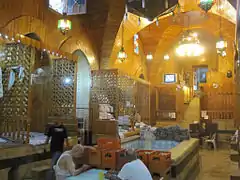
An old legendary story says that Damascus once had 365 hammams, one for each day of the year. For centuries, hammams were an integral part of community life, with some 50 hammams surviving in Damascus until the 1950s. As of 2012, however, with the growth of modernisation programmes and home bathrooms, fewer than 20 Damascene working hammams had survived.[53] As of 2004, only 13 hammams were still operating in their original function.[2]
According to many historians, the northern city of Aleppo was home to 177 hammams during the medieval period until the Mongol invasion when many vital structures in the city were destroyed. Until 1970, around 40 hammams were still operating in the city. Nowadays, roughly 18 hammams are operating in the Ancient part of the city.[54] Notable examples include:
- Hammam al-Sultan, built in 1211 by Az-Zahir Ghazi
- Hammam al-Nahhasin, built during the 12th century near Khan al-Nahhaseen
- Hammam al-Bayadah of the Mamluk era built in 1450
- Hammam Yalbugha built in 1491 by the Emir of Aleppo Saif ad-Din Yalbugha al-Naseri.[55]
- Hammam al-Jawhary, Gammam Azdemir, Hammam Bahram Pasha, Hammam Bab al-Ahmar and others
Egypt
.jpg.webp)
As in nearby regions, bathhouses had existed in Egypt for centuries before the arrival of the Arab Muslims in Egypt in the 7th century. Greek bathhouses were present in Alexandria, a capital of Hellenistic culture, as well as in other cities like Karanis in the Faiyum.[56] During the subsequent Islamic period, bathhouses continued to be built by Muslim rulers and patrons, sometimes as part of larger religious and civic complexes. Although not many have survived intact to the present day, numerous public baths were built by the Fatimids (10th-12th centuries), the Ayyubids (112th-13th centuries), the Mamluks (13th-16th centuries), and the Ottomans (16th-19th centuries).[57][58] One well-preserved medieval example is the restored Hammam of Sultan Inal, dating from 1456 and located at Bayn al-Qasrayn in Cairo.[59] Private hammams were also built as part of palaces, with surviving examples at the Palace of Amir Taz (14th century) and the Harim Palace (19th century), and of local aristocratic mansions such as Bayt al-Razzaz (15th-18th centuries) and Bayt al-Suhaymi (17th-18th centuries).[59]
Today, the cultural practice of visiting hammams has significantly receded in Egypt. Cairo once contained an estimated 77 operational hammams at the beginning of the 19th century, but only 33 were operating in 1969 and only 8 were still operating at the beginning of the 21st century, with many others abandoned or neglected.[60][27] Of the few still functioning hammams, many are also in precarious condition and scholars have indicated that they are likely to disappear or stop functioning in the near future.[61] A few hammams, mainly in the neighbourhoods of Historic Cairo, have been restored or have been earmarked for restoration as historic monuments, including the Sultan Inal Hammam, the monumental but ruined hammam of Sultan al-Mu'ayyad (located behind the al-Mu'ayyad Mosque), the Hammam al-Gamaliyya (located in the Gamaliya neighbourhood), the Hammam al-Sinaniya (in Bulaq), and the Hammam al-Sukariya (in Darb al-Ahmar).[61]
Turkey
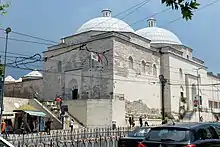
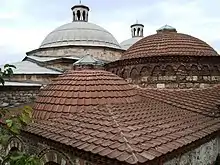
Public baths were a feature of culture in Turkey since Ancient Greek and Roman times. The Seljuk Turks, the first Muslims to settle widely across Anatolia, also built hammams in turn.[4] The largest number of historic hammams remaining today, however, come from the Ottoman period (14th-20th centuries). Many examples of early Ottoman hammams remain in Anatolia and the Balkans, particularly in the early Ottoman capitals of Edirne and Bursa, where many of their early structural and decorative features were established.[17] Many were built in association with particular mosques or religious complexes (külliyes). Among the notable pre-1454 examples (in various states of conservation) are the Orhan Bey Hamam in Bursa (built around 1339[62]), the Demirtaş Hamam in Bursa (14th century[63]), the Hacı Hamza Hamam in Iznik (late 14th or early 15th century[64]), the Çelebi Sultan Mehmet Hamam in Merzifon (1413[65][66]), the Mahkeme Hamam in Bursa (1421[67]), the Gazi Mihal Hamam in Edirne (1422, now partly ruined[68]), the Emir Sultan Hamam in Bursa (1426[69]), the Beylerbeyi Hamam in Edirne (1429, now partly ruined[70]), and the Karacabey Hamam in Ankara (1444[71]), along with many others of varying notability.[17]
After the conquest of Constantinople in 1454, Istanbul became a site of intense Ottoman architectural patronage. The city's oldest hammams include the Tahtakale Hamam (built soon after 1454), the Mahmut Pasha Hamam (built in 1466 and part of the Mahmut Pasha Mosque complex), the Gedik Ahmet Pasha Hamam (built in 1475), the Bayezid II Hamam (built some time between 1500 and 1507), and the Küçük Mustafa Pasha Hamam (built before 1512 near the Gül Mosque).[17][24] A number of major hammams in the city were designed by the famous Ottoman architect Mimar Sinan in the 16th century. These include the Çinili Hamam (built in 1545 in the Zeyrek neighbourhood), the Süleymaniye Hammam (part of the Süleymaniye Mosque complex built in 1550–1557), the Mihrimah Sultan Hamam (part of the Mihrimah Sultan Mosque complex built in 1562–1565), the Kılıç Ali Pasha Hamam (part of the Kılıç Ali Pasha Complex completed in 1580), as well as a lesser-known but architecturally notable hammam in Ortaköy.[72][17][24] The Çemberlitaş Hamam (on Divanyolu Street in the Çemberlitaş neighbourhood), completed in 1584 or earlier, is also attributed to Mimar Sinan's work.[24] The largest hammam designed by Sinan is the Haseki Hürrem Sultan Hamam which was commissioned by Suleiman I's consort, Hürrem Sultan, and completed in 1556 on the site of the historical Baths of Zeuxippus for the religious community of the nearby Hagia Sophia.[17][24] Outside Istanbul, Sinan built the Sokullu Mehmet Pasha Hamam in Edirne around 1568–1569.[73] Among the hammams built after the 16th century one of the most famous is the Cağaloğlu Hamam, finished in 1741 and one of the last major hammams to be built in Istanbul.[24]
Turkey also has a number of hot springs which have been developed as public baths for centuries. The Eski Kaplıca ("Old Thermal Baths") of Bursa, built by Sultan Murad I (ruled 1360–1389),[74] and the nearby Yeni ("New") Kaplıca built by Rüstem Pasha in 1552,[72] are some of the most notable examples and are still used today. Several older hot spring baths were also built in Turkey by the Seljuks in the 13th century and the Aqqoyunlu in the late 14th century, some of which are still operating today.[74]
Although far fewer in number than in previous centuries, many Turkish hammams are still operating today and continue to be relevant to both locals and tourists. Some have been recently restored or modernized with varying degrees of historical authenticity.[24][25][23] Other hammam buildings have ceased functioning as public baths but have been carefully repurposed as markets or cultural venues, as for example the Tahtakale Hamam in Istanbul and the Orhan Bey Hamam in Bursa.[23][24][75] In some cases hammam buildings have been repurposed as storage depots or factories, though this has often led to neglect and damage to their historic fabric.[23]
Greece
_01.jpg.webp)
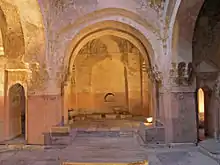
Greece contains a large number of historic hammams dating from throughout the Ottoman period, from the late 14th century to the 18th century. Two of the oldest remaining examples are the Gazi Evrenos Hamam in Giannitsa, dating from 1392, and the Oruç Pasha Hammam in Didymoteicho, dating from 1398.[19] Most buildings are abandoned, demolished or in a state of decay, but recently a growing number of them have been restored and converted to new cultural functions such as historic sites or exhibitions spaces. A 2004 study by Elena Kanetaki counted 60 remaining hammam buildings on Greek territory.[19]
In Thessaloniki, formerly a major Ottoman center in the region, the Bey Hamam was built in 1444 by sultan Murad II. It is a double bath, for men and women, with notable architectural decoration. The baths remained in use, under the name "Baths of Paradise", until 1968. It was restored by the Greek Archaeological Service and is now used as a cultural venue.[76][19][77][78] Another hammam, the late 16th-century Yeni Hamam, has been partially preserved and restored and now serves as a music stage venue.[19][79][77] The Pasha Hamam was built in 1520–1530, during the reign of Suleiman the Magnificent, and operated until 1981 under the name "Fenix Baths". Restored, it now houses archeological findings from construction on the Thessaloniki metro.
Elsewhere in Greece, examples of restored hammams include the Abid Efendi Hamam in Athens, restored in the 1990s and converted to the Center of Documentation in Body Embellishment.[19] In Rhodes, another double bath called the Yeni Hamam dates from the 16th century and was restored in 1992-1995. It is now one of only two hammams still operating as a bathhouse in Greece.[19]
Cyprus
The Omeriye Baths in Nicosia, Cyprus, date to the 15th century and is part of the larger complex of the Ömeriye Mosque (dedicated to the Caliph Omar). The complex was founded by Lala Mustafa Pasha in the 1570s, soon after the Ottoman conquest of Cyprus, by reusing the earlier 14th-century Augustinian church of St. Mary which was damaged in the Ottoman siege.[80][81] The hammam was restored in 2002-2004 as part of the Lefkosia Master Plan and is still in use today.[82] Another bathhouse, the Büyük Hammam, dates from the same period.[80]
North Macedonia
Some significant historic Ottoman hammams have also been preserved in North Macedonia. Two of the major examples in Skopje are now part of the National Gallery of Macedonia: the Daut Pasha Hamam (built in the late 15th century) and the Čifte Hammam (late 16th century).[17][28][83][84]
Hungary

Budapest, the City of Spas has four working Turkish baths, all from the 16th century and open to the public: Rudas Baths, Király Baths, Rácz Thermal Bath, and Császár Spa Bath (reopened to the public since December 2012).
India & Pakistan
Public baths have ancient precedents in Indian civilization. The Great Bath located in present-day Pakistan is a notable example dating from the 3rd millennium BC at the archeological site of Mohenjo-daro in the Indus Valley.[85] Islamic hammams were introduced after the spread of Muslim rule in the subcontinent starting mainly with the Delhi Sultanate in the 13th century and continuing across the later Mughal period (16th-19th centuries). Historically, however, public bathhouses in the Indian subcontinent were less common and less important than in other Muslim territories like Middle East or North Africa. This was due to the fact that, unlike most cities in those regions, water was already plentifully available in the natural environment across much of India, making the hammam less necessary to the act of bathing and the accomplishment of the full ablutions. While there were many richly-designed hammams in private palaces and mansions, very few historically public hammams existed which were of comparable importance to the hammams of Muslim cities further west.[5]
Delhi, Hyderabad and Bhopal in India have multiple working Turkish Baths, which were started during the Mughal period in the early 16th century.[86][87][88][89][90] Two prominent examples include the Hammam-e-Qadimi and Hammam-e-Lal Qila.[91]
In Pakistan, Shahi Hammam or Royal Bathhouse of Lahore, located in the historic Walled City, is one of the best preserved examples of a Mughal-era hammam. The hammam was built in 1634 by the Mughal governor of Lahore Hakim Ilmuddin Ansari, during the reign of Emperor Shah Jahan.[92][93]
Introduction to Western Europe
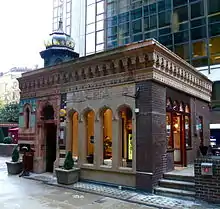
By the mid 19th century, baths and wash houses in Britain took several forms. Turkish baths, based on bathhouses in the Ottoman Empire, were introduced by David Urquhart, diplomat and sometime Member of Parliament for Stafford, who for political and personal reasons wished to popularise Turkish culture. In 1850, he wrote The Pillars of Hercules, a book about his travels in 1848 through Spain and Morocco. He described the system of dry hot-air baths used there and in the Ottoman Empire, which had changed little since Roman times. In 1856, Richard Barter read Urquhart's book and worked with him to construct a bath. Although this was not a success, Barter persevered, sending his architect to study the ancient baths in Rome. Later that year he opened the first modern Turkish bath at St Ann's Hydropathic Establishment near Blarney, County Cork, Ireland.[94] The following year, the first public bath of its type to be built in mainland Britain since Roman times was opened in Manchester, and the idea spread rapidly. It reached London in July 1860, when Roger Evans, a member of one of Urquhart's Foreign Affairs Committees, opened a Turkish bath at 5 Bell Street, near Marble Arch.
During the following 150 years, over 800 Turkish baths opened in the country, including those built by municipal authorities as part of swimming pool complexes, taking advantage of the fact that water-heating boilers were already on site.
Similar baths opened in other parts of the British Empire. Dr. John Le Gay Brereton, who had given medical advice to bathers in a Foreign Affairs Committee-owned Turkish bath in Bradford, travelled to Sydney, Australia, and opened a Turkish bath there on Spring Street in 1859, even before such baths had reached London.[95] Canada had one by 1869, and the first in New Zealand was opened in 1874.
Urquhart's influence was also felt outside the Empire when in 1861, Dr Charles H Shepard opened the first Turkish baths in the United States at 63 Columbia Street, Brooklyn Heights, New York City, most probably on 3 October 1863.[96] Before that, the United States, like many other places, had several Russian baths, one of the first being that opened in 1861 by M. Hlasko at his "natatorium" at 219 S. Broad Street, Philadelphia.[97] In Germany in 1877, Frederick I, Grand Duke of Baden opened the Friedrichsbad Roman-Irish baths in Baden-Baden. This was also based on the Victorian Turkish bath, and is still open today.[98]
As of September 2020 there were just eleven Victorian or Victorian-style Turkish baths remaining open in Britain,[99] but hot-air baths still thrive in the form of the Russian steambath and the Finnish sauna. A few of Britain's Turkish baths, while retaining their original decorative style, are now used for other purposes, such as day spas, restaurants, events venues[100] and business centres.[101]
The Turkish bath in art
Within the historic Muslim world, hammams appeared in some artistic depictions such as Persian miniatures, including the work of Kamāl ud-Dīn Behzād (or Bihzad).[4]
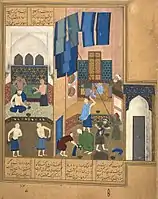 Bath house scene by Kamāl ud-Dīn Behzād, 1495
Bath house scene by Kamāl ud-Dīn Behzād, 1495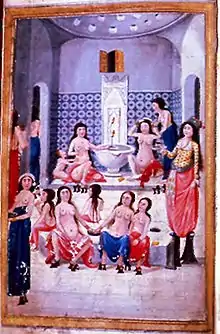 Women's bath, illustration from Husein Fâzıl-i Enderuni's Zanan-Name, 18th century
Women's bath, illustration from Husein Fâzıl-i Enderuni's Zanan-Name, 18th century
In Western art, especially in the context of 19th-century Orientalism, the hammam is often portrayed as a place of sexual looseness, disinhibition and mystery. These Orientalist ideas paint the Arab or Turkish "other" as mystical and sensuous, lacking morality in comparison to their Western counterparts.[102] A famous painting by Jean Auguste Dominique Ingres, Le Bain Turc ("The Turkish Bath"), depicts these spaces as magical and sexual. There are several women touching themselves or one another sensually while some dance to music played by the woman in the centre of the painting.
 Jean Auguste Dominique Ingres: The Turkish Bath, 1862 (Louvre, Paris)
Jean Auguste Dominique Ingres: The Turkish Bath, 1862 (Louvre, Paris) Le Hamam, by Jean-Léon Gérôme, 1870
Le Hamam, by Jean-Léon Gérôme, 1870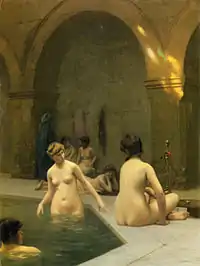 Baigneuses, by Jean-Léon Gérôme, c. 1889
Baigneuses, by Jean-Léon Gérôme, c. 1889 Après le bain, by Jean-Léon Gérôme
Après le bain, by Jean-Léon Gérôme
See also
- Gellért Baths
- Hydrotherapy
- Jjimjilbang, the Korean equivalent
- Onsen and sentō, the Japanese equivalents
- Steam shower
- Sauna
Notes and references
- M. Bloom, Jonathan; S. Blair, Sheila, eds. (2009). "Bath". The Grove Encyclopedia of Islamic Art and Architecture. Oxford University Press.
- Sibley, Magda. "The Historic Hammams of Damascus and Fez: Lessons of Sustainability and Future Developments". The 23rd Conference on Passive and Low Energy Architecture.
- Marçais, Georges (1954). L'architecture musulmane d'Occident. Paris: Arts et métiers graphiques.
- Sourdel-Thomine, J.; Louis, A. (2012). "Ḥammām". In Bearman, P.; Bianquis, Th.; Bosworth, C.E.; van Donzel, E.; Heinrichs, W.P. (eds.). Encyclopaedia of Islam, Second Edition. Brill.
- Blake, Stephen P. (2011). "Hamams in Mughal India and Safavid Iran: Climate and Culture in Two Early Modern Islamic Empires". In Ergin, Nina (ed.). Bathing Culture of Anatolian Civilizations: Architecture, History, and Imagination. Peeters. pp. 257–266. ISBN 9789042924390.
- Wehr, Hans (1979). Milton Cowan, J. (ed.). A Dictionary of Modern Written Arabic. Foreign Language Study. ISBN 9783447020022.
- Project, Living Arabic. "The Living Arabic Project - Classical Arabic and dialects". Lughatuna. Retrieved 11 October 2020.
- Theflatart (22 February 2019). "What is Turkish Bath: Hammam, Rituals and Benefits". Medium. Retrieved 11 October 2020.
- "Definition of HAMMAM". www.merriam-webster.com. Retrieved 11 October 2020.
- "Definition of TURKISH BATH". www.merriam-webster.com. Retrieved 16 October 2020.
- Hocine Benkheira, Mohammed (2003). "" La maison de Satan " Le hammâm en débat dans l'islam médiéval". Revue de l'histoire des religions. 220 (4): 391–443. doi:10.3406/rhr.2003.922.
- Fournier, Caroline (2016). Les Bains d'al-Andalus: VIIIe-XVe siècle. Rennes: Presses universitaires de Rennes.
- Raftani, Kamal; Radoine, Hassan (2008). "The Architecture of the Hammams of Fez, Morocco". Archnet-IJAR. 2 (3): 56–68.
- "BATHHOUSES (ḥammām, garmāba)". Encyclopaedia Iranica. Retrieved 2 October 2020.
- Aksit, Elif Ekin (2011). "The women's quarters in the historical hammam". Gender, Place and Culture. 18 (2): 277–293. doi:10.1080/0966369X.2011.552321. S2CID 146256016.
- Sarmento, J.; Kazemi, Z. (2014). "Hammams and the contemporary city: the case of Isfahan, Iran". International Journal of Heritage Studies. 20 (2): 138–156. doi:10.1080/13527258.2012.736873. hdl:1822/20890. S2CID 144523991.
- Kuban, Doğan (2010). Ottoman Architecture. Antique Collectors' Club.
- Sudár, Balázs (2004). "Baths in Ottoman Hungary". Acta Orientalia Academiae Scientiarum Hungaricae. 57 (4): 391–437. doi:10.1556/AOrient.57.2004.4.1.
- Kanetaki, Eleni (2004). "The Still Existing Ottoman Hammams in Greek Territory" (PDF). Middle East Technical University Journal of the Faculty of Architecture. 21: 81–110.
- Artan, Tülay (2011). "Forms and Forums of Expression". In Woodhead, Christine (ed.). The Ottoman World. pp. 386–387.
- Hamams in Islamic tradition (cyberbohemia.com) Archived 14 August 2004 at the Wayback Machine
- Koch, Ebba (2002). Mughal Architecture: An Outline of Its History and Development (1526- 1858). Oxford University Press.
- Büyükdigan, Ilter (2003). "A critical look at the new functions of Ottoman baths". Building and Environment. 38 (4): 617–633. doi:10.1016/S0360-1323(02)00184-1.
- Sumner-Boyd, Hilary; Freely, John (2010). Strolling Through Istanbul: The Classic Guide to the City (Revised ed.). Tauris Parke Paperbacks.
- The Rough Guide to Istanbul. Rough Guides. 2015.
- Sibley, Magda; Sibley, Martin (2015). "Hybrid Transitions: Combining Biomass and Solar Energy for Water Heating in Public Bathhouses". Energy Procedia. 83: 525–532. doi:10.1016/j.egypro.2015.12.172.
- Telmissany, May; Gandossi, Eve (2009). The Last Hammams of Cairo: A Disappearing Bathhouse Culture. The American University in Cairo Press. ISBN 9789774162435.
- Erdoğan, Nevnihal; Alik, Belma; Temel Akarsu, Hikmet (2018). "The Ottoman-Turkish Hamams in Urban History and Culture in Balkan Countries". 14th International Conference in "Standardization, Prototypes, and Quality: A Means of Balkan Countries' Collaboration": 93–102.
- Rahim, Habibeh (2001). "Understanding Islam". The Furrow. 52 (12): 670–674.
- Reinhart, Kevin (1990). "Impurity/No Danger". History of Religions. 30 (1): 1–24. doi:10.1086/463212.
- Ghazali, Abu Hammid (1975). The Mysteries of Purity: Being a Translation with Notes of the Kitāb Asrār Al-ṭahārah of Al-Ghazzāli's Iḥyāʼ ʻulūm Al-dīn. Lahore: Muhammad Ashraf.
- Ghazali, Abu Hammid (1975). The Mysteries of Purity: Being a Translation with Notes of the Kitāb Asrār Al-ṭahārah of Al-Ghazzāli's Iḥyāʼ ʻulūm Al-dīn. Lahore: Muhammad Ashraf. p. 51.
- Bouhdiba, Abdelwahab (1985). Sexuality in Islam. London: Routledge & Kegan Paul. p. 62.
- Joseph, Suad; Afsaneh Najmabadi (2003). Encyclopedia of Women & Islamic Cultures. Leiden: Brill.
- Nkrumah, Gamal (23 July 2009). "Tales from the Hammam". Al-Ahram Weekly.
- (Yilmazkaya & Deniz 2005) discusses occasional licentious activity
- Richard Boggs, Hammaming in the Sham: A Journey Through the Turkish Baths of Damascus, Aleppo and Beyond, 2012, ISBN 1859643256, p. 161
- Alexander Russell, The Natural History of Aleppo, 1756, 2nd edition, 1794, p. 134-5
- Kilito, Abdelfettah; Patricia Geesey (1992). "Architecture and the Sacred: A Season in the Hamam". Research in African Literatures. 23 (2): 203–208.
- Staats, Valerie (1994). "Ritual, Strategy, or Convention: Social Meanings in the Traditional Women's Baths in Morocco". Frontiers: A Journal of Women Studies. 14 (3): 1–18. doi:10.2307/3346678. JSTOR 3346678.
- Staats, Valerie (1994). "Ritual, Strategy, or Convention: Social Meanings in the Traditional Women's Baths in Morocco". Frontiers: A Journal of Women Studies. 14 (3): 1–18. doi:10.2307/3346678. JSTOR 3346678.
- Bouhdiba, Abdelwahab (1985). Sexuality in Islam. Saqi Books. p. 167.
- The Guide of Turkish Baths.
- "El Baño Andalusí (2 de 2) - Baños del Alcázar Califal | Visita Virtual". banosdelalcazarcalifal.cordoba.es. Retrieved 10 October 2020.
- M. Bloom, Jonathan; S. Blair, Sheila, eds. (2009). "Qusayr 'Amra". The Grove Encyclopedia of Islamic Art and Architecture. Oxford University Press.
- Sibley, Magda; Fodil Fadli (2009). "Hammams in North Africa: An Architectural Study of Sustainability Concepts in a Historical Traditional Building". 26th Conference on Passive and Low Energy Architecture.
- Sibley, Magda; Sibley, Martin (2015). "Hybrid Transitions: Combining Biomass and Solar Energy for Water Heating in Public Bathhouses". Energy Procedia. 83: 525–532. doi:10.1016/j.egypro.2015.12.172.
- Sibley, Magda; Jackson, Iain (2012). "The architecture of Islamic public baths of North Africa and the Middle East: an analysis of their internal spatial configurations". Architectural Research Quarterly. 16 (2): 155–170. doi:10.1017/S1359135512000462.
- "Summary of the discussions – ECO-HAMMAM". Retrieved 13 September 2020.
- Marçais, Georges (1954). L'architecture musulmane d'Occident. Paris: Arts et métiers graphiques. pp. 215–216, 315–316.
- "Arab Baths of the Caliphal Alcázar of Córdoba - "Caliphal Baths"". Arte en Córdoba. Retrieved 4 October 2020.
- Barrucand, Marianne; Bednorz, Achim (1992). Moorish architecture in Andalusia. Taschen. ISBN 3822896322.
- Hammaming in the Sham: A Journey through the Turkish Baths of Damascus, Aleppo and Beyond, Richard Boggs, Garnet Publishing Ltd.
- Alepo hammams
- Carter, Terry; Dunston, Lara; Humphreys, Andrew (2004). Syria & Lebanon. Lonely Planet. p. 186. ISBN 978-1-86450-333-3.
Hammam yalbougha.
- "Ancient Baths in Egypt". karanisbath. Retrieved 29 September 2020.
- MacKenzie, Neil D. (1992). Ayyubid Cairo: A Topographical Study. Cairo: American University in Cairo Press. pp. 93–101. ISBN 9781617977428.
- Behrens-Abouseif, Doris. 2007. Cairo of the Mamluks: A History of Architecture and its Culture. Cairo: The American University in Cairo Press.
- Williams, Caroline (2018). Islamic Monuments in Cairo: The Practical Guide (7th ed.). Cairo: The American University in Cairo Press.
- Raymond, André (1969). "Les bains publics au Caire à Ia fin du XVIII siècle". Annales Islamologiques. 8: 129–165. doi:10.1080/13556207.2008.10785032. S2CID 113006369.
- Fadli, Fodil; Sibley, Magda (2008). "The Historic Hammams of Cairo: Safeguarding a Vanishing Heritage". Journal of Architectural Conservation. 14 (3): 59–80. doi:10.1080/13556207.2008.10785032. S2CID 113006369.
- basin. "Eski Aynalı Çarşı (Orhan Hamamı)". Bursa.com.tr | Tüm Zamanların Güzel Şehri (in Turkish). Retrieved 14 October 2020.
- "TİMURTAŞ (DEMİRTAŞ) PAŞA HAMAMI". Kültür Portalı. Retrieved 14 October 2020.
- Mordtmann, J.H.; Fehérvári, G. (2012). "Iznīḳ". In Bearman, P.; Bianquis, Th.; Bosworth, C.E.; van Donzel, E.; Heinrichs, W.P. (eds.). Encyclopaedia of Islam, Second Edition. Brill.
- "Eski Hamam, Merzifon". kulturenvanteri.com. Retrieved 14 October 2020.
- merzifonpusula.com. "ÇELEBİ SULTAN MEHMED HAMAMI". Pusula Gazetesi - Günlük Siyasi Gazete Merzifon - Amasya - Suluova - Taşova - Hamamözü - Göynücek Haberleri (in Turkish). Retrieved 14 October 2020.
- "MAHKEME (İBRAHİM PAŞA) HAMAMI". Kültür Portalı. Retrieved 15 October 2020.
- "GAZİ MİHAL BEY HAMAMI". Kültür Portalı. Retrieved 14 October 2020.
- "EMİR SULTAN HAMAMI". Kültür Portalı. Retrieved 14 October 2020.
- "BEYLERBEYİ HAMAMI". Kültür Portalı. Retrieved 14 October 2020.
- "Hamamlar -". ankara.ktb.gov.tr. Retrieved 14 October 2020.
- Freely, John (2011). A History of Ottoman Architecture. WIT Press. ISBN 9781845645069.
- "Sokollu Mehmet Pasha Bath in Edirne | Turkish Archaeological News". turkisharchaeonews.net. Retrieved 15 October 2020.
- Orhonlu, Cengiz (2012). "Ḳapli̊d̲j̲a". In Bearman, P.; Bianquis, Th.; Bosworth, C.E.; van Donzel, E.; Heinrichs, W.P. (eds.). Encyclopaedia of Islam, Second Edition. Brill.
- "Eski Aynalı Çarşı | Bursa, Turkey Attractions". Lonely Planet. Retrieved 15 October 2020.
- Mazower, Mark (2007). Salonica, City of Ghosts: Christians, Muslims and Jews 1430-1950. Knopf Doubleday Publishing Group. pp. 39–40. ISBN 9780307427571.
- The Rough Guide to Greece. Rough Guides. 2015. ISBN 9780241216798.
- "Bey Hammam | Thessaloniki, Greece Attractions". Lonely Planet. Retrieved 16 October 2020.
- "Yeni Hammam | Thessaloniki, Greece Attractions". Lonely Planet. Retrieved 16 October 2020.
- Yıldız, Netice (2009). "The Vakf Institution in Ottoman Cyprus". In Michael, Michalis N.; Gavriel, Eftihios; Kappler, Matthias (eds.). Ottoman Cyprus: A Collection of Studies on History and Culture. Otto Harrassowitz Verlag. pp. 154–180. ISBN 9783447058995.
- Strohmeier, Martin (2015). "Omeriye: A Mosque in Nicosia". Journal of Muslims in Europe. 4: 58–69. doi:10.1163/22117954-12341295.
- The Rough Guide to Cyrpus. Rough Guides. 2016. ISBN 9780241291580.
- "Daut Pasha Hamam – Nationalgallery.mk". Retrieved 16 October 2020.
- "Cifte Hammam – Nationalgallery.mk". Retrieved 16 October 2020.
- "Great Bath | Definition, Description, & Facts". Encyclopedia Britannica. Retrieved 16 October 2020.
- "Turkish bath centre defunct at Nizamia general hospital". siasat.com. 11 January 2012. Retrieved 12 January 2012.
- "Where are those Turkish baths?". The Times of India. 11 June 2004. Retrieved 12 January 2012.
- "Centre keen on hammam". The Times of India. 27 November 2011. Retrieved 12 January 2012.
- "Hyderabad Attractions". The New York Times. 12 January 2012. Archived from the original on 20 November 2012. Retrieved 12 January 2012.
- Syed Zillur Rahman, Hammam – Past and Present, Newsletter of Ibn Sina Academy 2012, Volume 12 No 1: 10–16
- Gianani, Kareena (22 June 2016). "Bhopal's 300-Year-Old Hidden Hammam". National Geographic. Retrieved 28 February 2018.
- orientalarchitecture.com. "Shahi Hammam Bathhouse, Lahore, Pakistan". Asian Architecture. Retrieved 16 October 2020.
- "A Mughal bathhouse renewed: Shahi Hammam, Lahore Walled City, Pakistan | Aga Khan Development Network". www.akdn.org. Retrieved 16 October 2020.
- Shifrin, Malcolm (3 October 2008), "St Ann's Hydropathic Establishment, Blarney, Co. Cork", Victorian Turkish Baths: Their origin, development, and gradual decline, retrieved 12 December 2009
- Shifrin, Malcolm (2015). Victorian Turkish Baths. London: Historic England. pp. 51–2.
- The Brooklyn Daily Eagle, 3 October 1863
- To Philadelphians on behalf of the Natatorium & Physical Institute. 1860. p. 11. Retrieved 4 December 2012.
- Roman-Irish baths, Baden-Baden. Retrieved 16 December 2017
- "Victorian-style Turkish baths still open in the UK". Victorianturkishbath.org. Retrieved 29 September 2020.
- Victorian bath house
- Ashton Old Baths. Retrieved 16 December 2017
- Staats, Valerie (1994). "Ritual, Strategy, or Convention: Social Meanings in the Traditional Women's Baths in Morocco". Frontiers: A Journal of Women Studies. 14 (3): 1–18. doi:10.2307/3346678. JSTOR 3346678.
Primary bibliography
- Allsop, Robert Owen (1890), The Turkish bath: its design and construction, Spon (Deals only with the Victorian Turkish bath)
- Cosgrove, J. J. (2001) [1913], Design of the Turkish bath, Books for Business, ISBN 978-0-89499-078-6 (Deals only with the Victorian Turkish bath)
- Gazali, Münif Fehim (2001), Book of Shehzade, Dönence, ISBN 978-975-7054-17-7
- Shifrin, Malcolm (2015), Victorian Turkish baths, Swindon: Historic England, ISBN 978-1-84802-230-0
- Toledano, Ehud R. (2003), State and Society in Mid-Nineteenth-Century Egypt, Cambridge University Press, ISBN 978-0-521-53453-6
- Yilmazkaya, Orhan; Deniz, Ogurlu (2005), A light onto a tradition and culture: Turkish baths: a guide to the historic Turkish baths of Istanbul (2 ed.), Çitlembik, ISBN 978-975-6663-80-6
External links
| Wikimedia Commons has media related to Hammams. |

.jpg.webp)
.jpg.webp)
